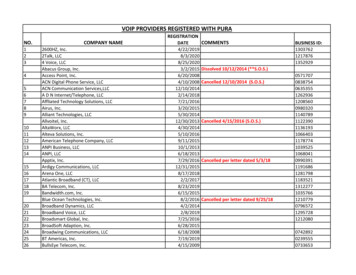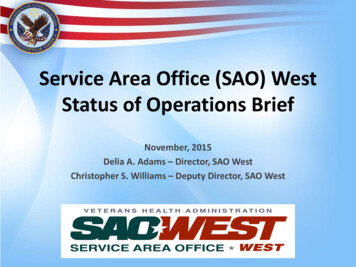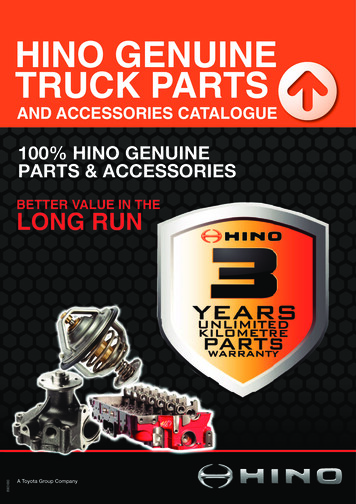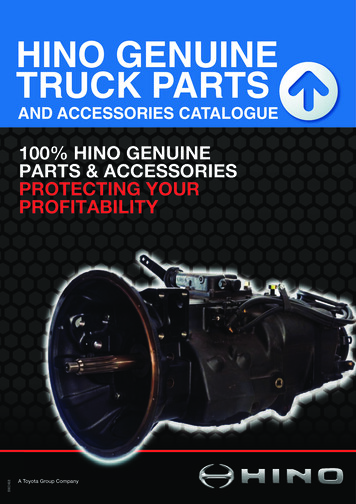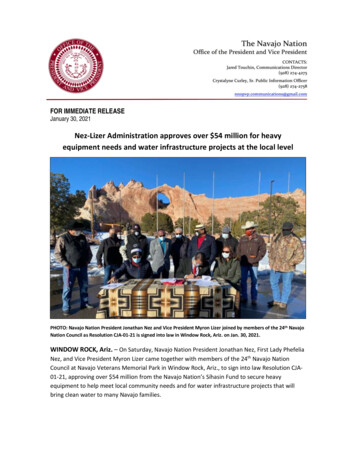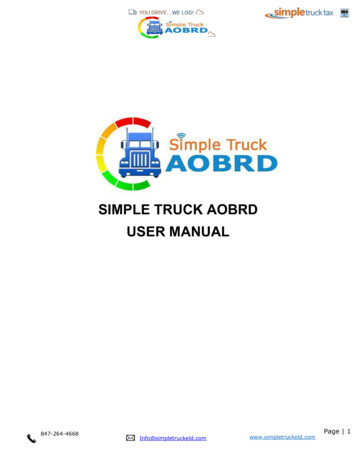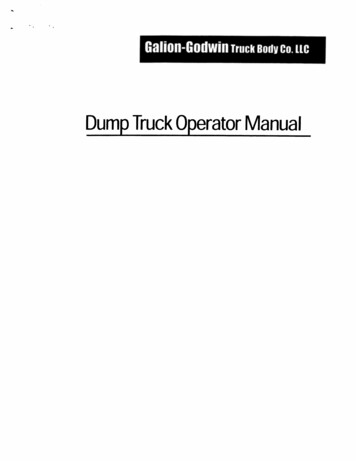
Transcription
Galion-Godwin Truck Body Co. LLCDump Truck Operator Manual
Galion-GodwinTable of ContentsSection 1: important Safety information.2Section 2: Pre-trip Inspection3356Pre-Trip Inspection ChecklistElectrical CheckOperational CheckSection 3: Driving an Empty Truck8Section 4: Loading the Truck8SectionS: Driving a Loaded TruckrnSection 6: Dumping Operations12Section 7: PTO Operations1313Instructions for Power Take Off OperationSection 8: Tailgate Removal14Section 9: Special Situations15151618Asphalt SpreadingAsphalt PatchingCounterbalance and Emergency Lowering InstructionsSection 10: Options202020Heated BodyDouble Acting TailgateSection 11: 3Conversion HoistsTwin Telescopic Conversion HoistsFront Lift Telescopic HoistsUnderbody HoistsSection 12: Hydraulic OilOilSupply.Oil SpecificationsProper Procedure for Filling a Galion-Godwin Hoist with Hydraulic OilGalion-Godwin Operated by Hydraulic SystemsNot Furnished by Ga lion GodwinTelescopic CylinderCylinder SleevesMaintenance and Service Recocd-.,.,2424252626282829
Section 1Important Safety InformationImportant Safety InformationThis Galion-Godwir, dump truck body isconsidered heavy-duty equipment. While wehave tried to make it as safe as possible, you andthose around you can still be seriously hurt orkilled if the unit is operated or maintainedimproperly. It is very important that youthoroughly understand this manual and that youfully and completely comply with all of theinstructions contained in this manual. They arehere for your safety; please follow them.Occupational safety and health laws require thatall dump trucks be equipped with locking controllevers, body props and backup alarms. SeeFigure 1.1. It is against Federal law to operate thismachinery without this equipment in place andoperational.In addition, we have provided your body withsafety features which, while not mandated byfederal law, are still important for your safety.These devices include warning decals, a hoistcontrol lever that is spring loaded to return toneutral whenever you release the control lever(this is known as a “dead man” control) and abody-up light. NEVER OPERATE THIS DEVICE IFANY OF THE REQUIRED SAFETY FEATURES AREMISSING OR INOPERATIVE. REMEMBER,SAFETY IS EVERYONE’S JOB.Control TowerIf your unit is not equipped with one of the threeunits shown, you should obtain, read andunderstand the instructions for the factorysupplied control tower in your truck. See1.la-1.lc.Figure 1.la2-Single Lever Control TowerFigure 1.lbGaIion-Goilwiu-Single Lever With Air Control Tower
Section 2Pre-Trip InspectionGalion-GodwinPre-Trip InspectionAAUse caution when climbing on the body. Makesure there Is no oil, dirt or debris on either yourshoes or any of the surfaces you climb on.WARNINGOperate tmcks only in well-ventilated ereas.Running any vehicle in an enclosed area can leadto a build-up of carbon monoxide. Carbonmonoxide can cause asphyxiation and death.AWARNINGNever leave a raised body unattended.A proper pre-trip inspection is necessary in orderto insure that your dump truck is in a safe androadworthy condftion before you start out on theroute. AU of the items on this pre-trip inspectionchecklist are important. The unit should never beoperated if any of its equipment is not in safeworking order. Experience has shown that it isespecially dangerous to operate this equipment ifthe dump body’s safety equipment (the lockingcontrol lever, the deadman control, the bodyprop, the body-up light and the backup alarm) isnot in good working order. NEVER OPERATE ADUMP TRUCK UNLESS ALL OF THESEFEATURES ARE FULLY OPERATIONAL AND ALLOF THE VEHICLE’S SAFETY SYSTEMS (LIGHTS,BRAKES, WIPERS, ETC.) ARE IN GOODOPERATING CONDITION.The procedures outlined here pertain only to thedump body and hoist assembly and generic itemsthat should be checked before driving anymotorized vehicle on the highway. In addition tothe following items, you must follow all pre-triprecommendations by the manufacturer of thechassis and all state and federal pre- and post-tripinspection requirements.PreTrip Inspection ChecklistWalk-around inspection.WARNING2. If you need to climb on the body or the truckat any time during the inspection process,make sure there is no oil, grease or otherslippery substance on either your shoes orany of the truck surfaces. Remember to keepeither both feet and one hand or both handsand one foot firmly and safely in contact withthe truck or the body at all times while youare climbing.3. Check to make sure the pins holding thetailgate at the top are fully engaged andsecured by the pin keeper. See FIgure 2.1.Figure 2.14. Check tailgate latching assembly. The hooksmust be securely fastened over the pins onthe tailgate. Four different bottom tailgateand latch assemblies are in use. SeeFigure 2.2a-2.2d.Figure 2.2a1. Check rear hinge area for visible damage,loose or missing pins, cracking, bending orother damage to the truck frame in the area ofthe rear hinge.3
UNTS.Section 2Pre-Trip InspectionGalion-Godwin7. Check to make sure that all lights, lenses andreflectors are intact.8. Check the general condition of the dumpbody. Make certain there is no excessive rust,damage, etc.9. Check and clean ladders and steps. Grease,mud and other debris could make themslippery and extremely dangerous.10. Check condition of the truck suspension,including springs, shackles, air bags, andother components.11. Check, clean and adjust all mirrors.12. Check tire pressure per markings on the tires.13. Check to make certain all warning decalsare on the body and are clean and legible.Figure 2.3a-2.3t contains drawings showingthe proper decals included in your decalpacket.—Figure 2.3aCAUTIONCPAflO*VER HOMTIfl.yEU PAWADMCislS?MRI1)MUMA *WPtflM NT.L1AI IYRAis Im*TTMM10VICA WRIER ICC?-.iselr*LCA PSAnY RAsyM41ciaOAe1 , **afl,,w.ci ORS.*ae.ass boy is p10 TOPICHEITACO.*t.w*va .—,—-- wiu.tis sons UCCRIbATTTT0 UA IosmY10IV51cL1 is ONr.*ATw DONTICLI MUST.IAI IC?CIC fl FRONT OFINS ICC? — SPY. l*3 **OVI 115 CIMSIlI PAINS.OFICATCA T*T cCIIlRm. SI CII CUICII ALLFigure 2.3bNOTICENO ONE SHALl. OPERATE OR SERV,S ThisUNITTHEY HAVE ROAD ASIC UNDEREFAMU 1HE OPERATION AbCMAINTENANCE MANUALS SUPPI. .o0ONAb. COPIES OP MANUALS MAY SE DETAIl.ED FROM YOUR WEAN I?DISIWSUTOR OR IT CONTACTINC 11IEPACTORWHEN ORDENSISMANUALSALWAYI SPECIFY MOOIE. AND SERIAL NUMIER OP TN! PRODUCT.154701-A5. Look under the truck for any dripping oil oraccumulation of oil or grease on the floor orother signs of leakage.6. Check for broken windshield and door glass.4
Section 2Pre-Trip InspectionGalion-GodwinFigure 2.31Figure 2.3c.u.uu.u’s.s.CAUTIONBODY.00 UNDER A RAISED00 UlCER A RAISED BODY TNOIIT PROPv’wIG IT. BODYlCST BEojEDIG DUMPING OPERA11ONS NO OIIS SHALL STAND SI OR ROVETNROUQI4 TUB AREA WHERE mElODY AND HOIST OPERATE ORLORD 110W DISCUAROLQPBRATQ JBT PMA ar CT.S IN CAR DURING DUMPINGCPERAPORMSED OR PARTLY RAISED WIlL! VEHICLEQQ. L!AV! BODYIS UNATTENDED OR WHILE PERFOIW0 MAII(TV4ANC! OR SEA.VIOl UNDER BODY UNlESS BODY IS PROPPED TO PREVENT ACCIDENTAL LOWERING. OPERATION OF BODY PROPu.ccv PmcPSR- U.Ii.UU-m,.n.,L flT t?LYL. .,—n.,.,mi. ‘vu.,.rrUUUai flIIT*IMTF igure 2.3dS--U .I?POWUUUUUNTR —NDWW pi RU RU RUR RU RU U RU RUCAUTIONDO ROT GO UNDER A RAISED LOADED BODY.DO NOT GO UNDER A RAISED BODY WITHOUT PROPPING IT BODY MUST BE ETY.*DO NOT LEAVE RAISED BODY UNATTENDED WITHOUT PROPPINDO NOT POWER DOWN WHILE BODY IS PROPPED.SEE OWNERS MANUAL FOR CORRECT OPERATiON10-47613.8OF BODY PROPS.14. Check the condition of spreader chains andtheir attachment. Make certain welds holdingthem to the tailgate are solid and no links areshowing signs of damage.15. Check the banjo eyes (the chain adjustingbrackets) for signs of wear, cracking welds ormechanical damage.16. Check the condition of the tailgate. If thetailgate is equipped with a coal door or similardevice, make sure that it is operating smoothlyand properly and latches securely.17. Check for any signs of torn metal, rust orcracking welds.Figure 2.3e18. Clear all debris off of any extension pans.CAUTIONJW.L 1U! A MAi%aIY nflRKh, 9r0. 5d11! flP C5.J.Lmime DUW. CPANAI1OW ND 0w IHMJ. erAim am iovi T1UOW fl41ANNA NN T) V AND H01 OPINaTI ON LOAD IDKT ODC4ANON.ODLIM1 eOUrPANfl.Y RADmG.IM4IcLI *tA BODY &ICDY SpNaPrO NS8AcctcwNSIeAIMAVI r-PTêHOD1S OTM 11 ON INiMIAmTyO*A ALOANBO lOOT NDl.I — U1flONAID.19. If your unit is equipped with sideboards,check to make sure that they are properlysecured.20. Check the condition of the cab shield. Be onthe lookout for excessive damage, rust, tornmetal or cracked welds.Electrical Check1. Turn on the ignition, place the transmission inreverse and check for operation of the backupalarm and backup lights, if so equipped.2. Check headlights, taillights, and brake lights.3. Check operation of windshield wipers.4. Check operation of body-up light. Startengine, engage power takeoff (see Section 7)and raise the body approximately six inches.The body-up light should come on at that time.5
Section 2Pre-Trip InspectionGalion-Godwin5. Lower body.Operational CheckAWARNINGDo not operate the unit if any safety feature doesnot work. It is extremely dangerous to do so.1. If your unit is equipped with a sight gage onthe hydraulic tank, make certain that the oillevel shown is in the normal operating rangeon the sight gage. If your unit is not equippedwith a sight gage, proceed to Step 2.Figure 2.4 On all Galion-Godwin hoists furnishedfor use with bodies under 17 feet, one propis supplied. For all Galion-Godwin hoists furnishedfor use with bodies over 17 feet, two propsare supplied. When a dump body is shipped without a hoist,body prop(s) are furnished as they are with thehoists.3. Raise the body and deploy the body prop(s).(Refer to the decal on the truck for proper bodyprop operation.) Body prop(s) come in threeFigure 2.5a-Underbody Prop UpFigure 2.4.AWARNINGMake certain that you have proper overheadclearance. Never raise a body underneathoverhead obstructions, power lines, etc. Ifyouining to spread, check overhead clearancefor the entire length of the area over which youwill be spreading.2. Start the unit, engage the power takeoff (seeSection 7) and cycle the unit all the way up anddown two or three times, making certain theunit goes all the way up and that it operatessmoothly through its entire range of motion. Ifthe unit fails to operate properly, it must beserviced before use.NOTE: Gal ion-Godwin hoists are equipped withpositive means of support, permanently attached,and capable of being placed in position to preventaccidental lowering of the body whilemaintenance or inspection work is beingperformed. The supports are designed tosupport an empty body only.6basic styles. See Figure 2.5a-2.5c.4. Inspect the condition of the props.A. Make certain that the props show no signsof deterioration due to rust, mechanicaldamage or bending before deploying theprop.8. If the props are damaged. do not deploythem and do not go further until the
Section 2Pre-Trip InspectionGalion-Godwinthe handle to check hoist control. It must returnto neutral and the body motion must stop whenyou release the handle.8. Make certain that the locking control featureis operative. This requires you to push abutton in order to move the control lever ineither direction from neutral.(See Figure 1.ia tic on page 2)*4kWARNINGAn improperly adjusted tailgate releasemechanism could cause a sudden and unintendeddischarge of the load. Component damage andpersonal injury can occur.damaged props are repaired.5. With the body securely propped. remove theignition key, lock the truck door, then inspectthe cylinder and pump area for leaks. Checkhoses for damage or leakage and check forworn or missing parts.6. If you are engaged in highway spreadingoperations and use a cable cutoff or hoist stopto control body height, perform the followingoperations:A. Extend the body to the maximum height.B. Check to make certain that the height isseveral inches lower than the lowestobstruction on your route and in no event9. Check operation of the tailgate release. For a manual control, please note that itshould take approximately 50 to 60 poundsof force at the handgrip to release aproperly adjusted tailgate. For electrical or air controls, make sure thatthey are operating properly and that thepins and latches secure the tailgatecompletely.10. After completing this check, make certain thatthe tailgate is properly and securely latched.The hooks should extend completely over thepins and should be difficult and require aconsiderable tug for each hook to moveacross the pins. Figure 2.7.greater than 13 feet. Figure 2.6.AkWARNINGStow body props properly before lowering thebody. For basic operations, see decal on body forproper instructions.7. Lower the body. On the way down, releaseHooks must extend at least 1/4” past centerlineof pin.11. If your unit is so equipped, check operation oftarp, spreaders, vibrators and any otheroptional or additional equipment. Refer toOEM operating instructions for these items.12. Perform all inspections recommended by thechassis manufacturer or required by your7company’s pie-trip inspection checklist.
Section 3Galion-GoliwinDriving an Empty TruckDriving an Empty TruckYou will have to adjust your driving to thecharacteristics of the dump truck.AIn general, you must avoid sharp lane changemaneuvers, go slowly on turns and give yourselfmore room to stop and more time to accelerate.Failure to do so could cause an accident involvingpotential serious injury or loss of life.WARNING Make certain the body is down. Never drive adump truck with the bed up, even slightly. Ifthe body-up light is on, stop the truckimmediately and determine the reason. Donot drive if the body is up.AWARNING Never let anyone ride any place in, on or aboutyour dump truck other than inside the cab in adesignated seating position, securelyrestrained by seat and shoulder harnesses.Always disengage power take-off when driving.Damage to PTO or pump and personal injurycan occur. Never drive a unit with the tailgate in theclown or work position.Loading the Truck Never drive a unit with a coal door (if soequipped) that is not fully closed and latched. If so equippe4 never drive a dump truck witha barn door in the open position. Never drive a dump truck with the power takeoff engaged. This leads to the possibility of aninadvertent raising of the bed. Never drive an empty dump truck withoutmaking certain that the tailgate is locked andtop hinge pins are propeily installed. Never drive a dump truck without makingcertain that the hoist control is locked in theneutral position Never drive an empty truck without makingcertain that you have swept all the debris offthe cab protecto. rub rails, extension pan,steps, Iaddei etch Make certain that there isno grease, oil or other slippery substance onyour hands, feet or the swfaces you will touch.Remember that you must keep both handsand one foot or one hand and both feet incontact with the truck at all times whenclimbing on the truck.WARNINGDo not attempt to load the body on soft groundor on ground that is not leveL Loading on soft orunlevel ground could cause the unit to tip overand creates the risk of serious injury or death.Even though the truck appears to be stable whenit is empty, it can still sink or tip as the load isbeing applied.The proper procedure for loading the body is asfollows:1. Lower the body.2. Disengage the power take off.3. Securely latch the tailgate with the hookscompletely over and securely holding thetailgate pins. Both hooks must be under equaltension when moved from side to side. Thehook should extend completely over the pinand it should be difficult and require aconsiderable tug to cause each hook to moveacross the pins. Figure 4.1.Figure 4.1A dump truck is wider and higher than a car orlight pickup truck. Make sure there is adequateclearance. It also has a higher center of gravity.Therefore, a dump truck is much more likely toroll over than a passenger car or light pickuptruck.Also, because of its size, it will take longer toaccelerate and to stop than a passenger car orpickup truck. When the truck chassis is empty,the rear brakes may lock up or tend to skid,causing loss of vehicle control, particularly onwet, icy, snowcovered or other slippery surfaces.B
Section 4Loading the TruckGalion-Godwin4. Fully close and securely latch the coal door, ifso equipped. Guillotine and over center aretypical latch coal doors. See Figure 4.2.Figure 4.2-Guillotine Coal DoorOver Center Coal Door7. Evenly distribute the load side to side. Do notoperate truck if load is not centered. SeeFigure 43.Figure 4.38. Load from front to rear, distributing the loadas evenly as possible.9. When loading with an end loader, load fromthe center of the body’s sides.10. When loading under a hopper, always parkwith the body of the truck centered from sideto side under the hopper opening and withthe hopper opening slightly forward of thecenter point of the body.11. The load must not be higher than the sides ofthe dump body or the sideboards, if soequipped. Figure 4.4.AWARNINGUse caution when climbing on the body. Makesure there is no oil, dirt or debris on either yourshoes or any of the surfaces you climb on.5. If you need to climb on the body or the truckat any time during the loading process, makesure there is no oil, grease or other slipperysubstance on either your shoes or any of thetruck surfaces. Remember to keep either bothfeet and one hand or both hands and one footfirmly and safely in contact with the truck orthe body at all times while you are climbing.6. Make certain there is proper clearance for theloader both from side to side and overhead.Except when loading from a hopper, neverattempt to load under any overheadobstruction.12. Before leaving the loading site, remove alldebris from rails, sills and other horizontalsurfaces.13. Tarp the load according to your local andstate requirements and as necessary toprevent any portion of the load fromescaping.9
Section 5Driving a Loaded TruckDriving a Loaded TruckAWARNINGUnless you are engaged in spreading1 never drive a dump truck with theoperationsbed up, even slightly. Make certain the body isdown. If the body-up light is on and you arenot spreading, stop the truck immediately anddetermine the reason. Do not continue tooperate until the body is down. Never let anyone ride any place in, on or aboutyour dump truck other than in the cab in adesignated seating position, securelyrestrained by a seat belt and shoulder harness. Never drive a unit with the tailgate in thedown or work position. Never drive a unit with a coal door (1(50equipped) that is not fully closed and latched.See Figure 4.2.GaIion-GoiIwinthe effect of reducuig the weight on the frontwheels of the truck If the unit was loaded to therear or the load has shifted to the rear, you mayencounter situations where you are unable to steerthe truck, especially on wet, slippery or icy surfaces,or when braking. Further, braking could cause thefront wheels to lock up, reducing ft efficiency ofthe braking system and resulting in a much longerstoppw,g distance particularly on wet, slipper.)snowy or icy swiaces.Use extreme caution when traveling across aninclined sLaface such as the side of a hilL Nevertravel on soft ground when crossaig a hill side.Never cross an incline greater than 6 degrees, asthe likelihood of the vehicle tipping over is toogreaL When crossing less steep k,cikies, be alertto any sign of the load shifting. See Figure 51.Figure 5.1 Never drive a loaded dump truck with a barndoor in the open position. Never drive a dump truck with the power takeoff engagecL This could result in aninadvertent raising of the bed. Never drive a loaded dump truck withoutmaking certain the tailgate is locked. SeeFigure 2.5. Never drive a loaded dump truck withoutmaking certain that the hoist control is lockedin the neutral position. See Figure 1.1. Never drive a loaded dump truck withoutmaking certain that you have swept all thelebris off the rub rails, extension pan, steps,iJer and other horizontal surfaces. Whenclimbing on the truck, make certain there is nogrease, oil or other slippery substance on yourhands, feet or the surfaces you will touch.Remember that you must keep both handsand one foot or one hand and both feet firmlyin contact with the truck at all times whenclimbing on the truck. Be aware of the possibility of load shift,particularly when hauling large objects, suchas boulders, large chunks of broken concreteor liquids etc. If the load shifts outward as youare making a turn, it could cause you to losecontrol of the vehicle and possibly roll it over. Ifyour truck is loaded toward the rear (or ifyouhave dumped a partial Ioa4 which will cause theremaining load to shift to the rear), it could have10 Never leave the driver’s position of the truckwithout shutting off the ignition, k,ckh thedoor, and taking the key.Never leave a raised body unattendecLNow that your truck has a load in it, it may have aneven higher center of gravity and it will weighconsiderably more than it did empty. Therefore, itwill take even longer to accelerate and stop than itdid when it was empty. It is even more prone to rollover on a curve or during a sudden evasivemaneuver. You will have to once again adjust yourdriving to the characteristics of your loaded truck. Ingeneral, you must make even more gradual lanechanges, go even slower on turns and give yourselfmuch more room to stop or accelerate or mergewith traffic. Failure to do so could cause an accidentinvolving potentially serious injury or loss of life.
Galion-GodwinDumping OperationsASection 6Dumping OperationsFigure 6.1WARNINGDumping operations are potentially extremelyhazardous. There is a possibility that the truckcan roll over, particulady if it Is on uneven or softground. Persons on the ground could be severelyinjured or killed if struck by a discharging load.You or others can be injured if a load hangs up orifyou have not opened the tailgate. Extremecaution must be exercised during dumpingoperations.Perform the following steps when you reach thearea where your load will be discharged:AWARNING5. If you are planning to dump through a coaldoor, open and set the coal door at this point.See Figure 6.2a-6.2b.No one should ride in, on or around the truckduring dumping or spreading operations exceptin a properly designated passenger seat with seatbelts and shoulder harnesses securely fastened.1. Check the terrain. Make sure it is level, evenand firm. Do not attempt to dump if there is asignificant sideways slope 6 degrees or greaterto the ground, or if it appears exceptionallymuddy or moist.2. Check carefully for overhead obstructions.Never raise the body or dump under a powerline, as you or someone else could beelectrocuted and killed or you could knock outpower to a large area.3. Check to make certain how many persons arein the vicinity where dumping will take place.‘Make certain all personnel are cautioned tostay out of the area where the load maydischarge. When dumping, make sure all personnelare accounted for, in sight arid out of thedischarge area.4. If you are planning to use the spreader chains,set them to the appropriate length and fastenthem in the mounting brackets provided.Chains should be set to an equal length. SeeFigure 6.1.WARNINGContents of body may be extremely hot. Wearproper attire when operating body. Personalinjury can result6. Check the dumping area carefully. Makecertain that there is adequate clearance for theload to discharge, both to the rear and the sideof the unit. Remember, when the loaddischarges, it will spread not only to the backof the truck, but also to the sides.You are now ready to dump your load. Pleasefollow the procedure outlined.1. Make certain your safety belt and shoulderharness are securely fastened.2. Release the tailgate. (If you forget to releasethe tailgate arid the body will not come backdown, see Section 9 for emergency loweringprocedures.)3. Engage power take off.11
Section 6Dumping OperationsGalion-Godwin9. Disengage the power takeoff.10. Turn off engine and remove ignition key soyou can perform the following checks.WARNiNGIfyou need to swing the tailgate manually, takegreat care not to get your fingers between thetailgate and the body of the truck, as the tailgateis extremely heavy and serious injury can occur.NOTE: It may be necessary to clean out the end ofthe bed to allow the gate to swing fully closed,particularly if you have dumped a partial load.4. Double check to make certain that allpersonnel are in sight, accounted for and outof the discharge area. Double check theoverhead clearance.5. Begin to raise the body slowly to the desireddump angle. Continue to be vigilant to makecertain that no one goes behind the truck or indischarge area during dumping operations.Be especially vigilant on this point whendumping in confined areas. See Figure 6.36. When the load begins to discharge, pullforward gradually until you have dumped thedesired amount.7. Lower the body slowly. Make sure the body isfully down and the body-up light is off.8. Make sure the hoist control lever returns toand is locked in neutral.1211. Close the gate. Check to make certain thatthe hooks are completely over and securelyholding the tailgate pins. Both hooks must beunder equal tension when moved from sideto side, The hook should extend completelyover the pin and it should be difficult andrequire a considerable tug to cause eachhook to move across the pins. See Figure 6.4.12. If you have dumped a partial load, beespecially careful that the tailgate is closed.13. Clean off debris from all horizontal surfacesof the truck.
Galion-GodwinSection 7PTO OperationsInstructions for Power Take OffOperationAWARNINGDisengage PTO before driving vehicle.Power take off (PTO) operation is controlled byeither a cable, electric hydraulic system, or airshift system.To engage PTO on standard transmissions,perform the following steps:1. Shift into neutral, disengage the clutch andmove the control to shift PTO into gear.NOTE: It may be necessary to let out the clutchmomentarily for proper alignment so the gearmay slide into position.2. Engage the clutch and the PTO is in operation.To engage the PTO on automatic transmissions,perform the following steps:1. Apply the brake and shift into any one of thedrive positions. This will stop the transmissiongears from turning.2. Shift PTO into gear, then shift transmission intoneutral. This will start transmission gearsturning, and in turn, put PTO into operation.13
Section 8Tailgate RemovalTailgate Removal2. Raise the chain attached to the tailgate to thepoint of load transfer.A3. Remove the tailgate upper pins.WARNINGDO NOT attempt to lift the tailgate with theupper hinges, since release of the upper hingepins could cause the tailgate to swing down withpossible injury.WARNINGDO NOT attempt to lift the tailgate with theinstalled spreader chains, since these chainswould provide an unstable center of gravityattachment point, which could swing downcausing possible injury.1. Before removing tailgate have unit settinglevel. Return body down to frame, shut offengine, set brakes and chock wheels.AWARNINGIfyour tailgate is equipped with a center liftingeye, attach a chain or cable tailgate to a hoist orother means of lifting the tailgate. Make certainyour cable or chain and hoist are ratedadequately, since some larger tailgates canweigh as much as 800 pounds.If your tailgate is not equipped with a lifting eye,install one to the top center of the tailgate asshown in Figure 8.1.14Galion-Godwin4. Open the tailgate lower hardware using thetailgate release mechanism.5. Assuring the bottom pins are free and theupper hinges are not binding to allow removal,remove the tailgate carefully by using acombination of lifting and rearward travel.6. Store the removed tailgate in a secure position,preferably horizontal one, to assure the tailgatedoes not fall and remove the chains or cablefrom the lifting eye.7. Simply reverse the above procedure to installyour tailgate.
Galion-GodwinSpecial SituationsAsphalt SpreadingAWARNINGContents of body may be extremely hot. Wearproper attire when operating body. Personalinju,y can resulLThis section deals with the special cautions thatneed to be taken when spreading asphalt inpaving operations on highway locations. Highwayspreading of asphalt presents special hazards,due to not only the busy work area and the traffichazards but also because the asphalt is hot.Section 9Special Situations When dumping make sure all personnel arecautioned to stay out of the discharge area,especially between the paver and the dumpbody. Make sure the spill shields on the sideof the paver are set to prevent the loaddischarging to the sides. If you are planning to use the spreaderchains, set them to the appropriate lengthand fasten them on the brackets provided.Chains should be set to an equal length.See Figure 9.1.Whenever you are performing operations in apublic highway right of way, you should followthe regulations promulgated by the OccupationalSafety and Health Administration and local lawsand ordinances.1. No one should ever ride on the truck duringasphalt spreading operations except in the cabin a designated seating position with seat beltsand shoulder harnesses, if so equipped,securely fastened.2. Remember that asphalt is very hot. Use cautionto avoid getting asphalt on clothes, shoes orexposed flesh. The hot asphalt will make thedump body hot and touching the hot metal maycause burns to unprotected body parts.3. Never drive the truck from location to locationwith the tailgate in the down or loweredposition.4. When dumping into a paver use the samecautions as other dumping operations.Make sure the area is level, even and firm. Donot attempt to dump into a paver if there is asignificant sideways slope of 6 degrees ormore
4. Check operation of body-uplight. Start engine, engage power takeoff (see Section 7) and raise the body approximately six inches. The body-uplight should come on at that time. Figure 2.3c CAUTION 00 UNDER A RAISED BODY. _ 00 UlCER A RAISED BODY TNOIIT PROPv’wIG IT. BODY lCST BE
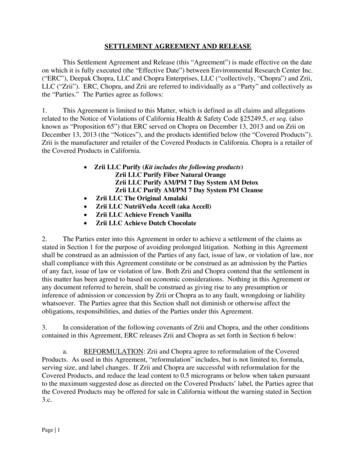
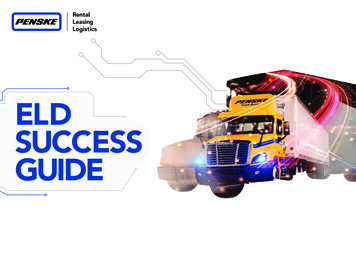
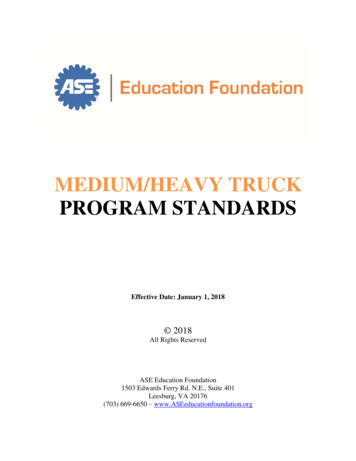
![Bosch ESI[truck] Heavy Duty Truck Software Update – Q2 .](/img/22/bosch-esitruck-heavy-duty-truck-release-notes-details-2019-2-0-0-0.jpg)

